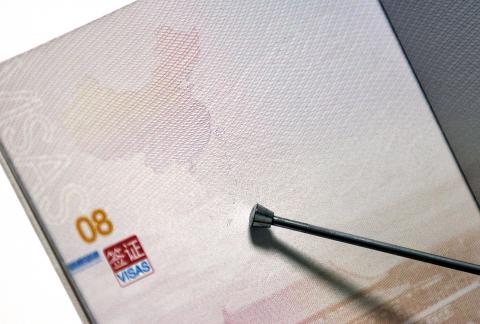|
India fights
tit-for-tat on passport map
PAPERS CUT: The country is now stamping its own
map on passports in response to Chinese passports claiming disputed territories.
Taiwan has no plans to follow suit
AFP, NEW DELHI

A pointer indicates where
disputed islands and territorial waters are situated in the map of China that
includes the South China Sea, printed on page 8 of the new China passport, in
Fuzhou, Fujian province, China yesterday. Several neighboring countries have
lodged diplomatic complaints on the territorial disputed part on the passports,
for its 3.5 million square km is one of the world¡¦s shipping routes and holds
rich fishing grounds.
Photo: EPA
India is stamping its map on visas given
to Chinese visitors, an Indian official said yesterday, after China began
issuing passports showing disputed territories as its own.
¡§We have started issuing visas with India¡¦s map as we know it,¡¨ said a foreign
ministry official, who did not wish to be named, declining to comment further.
India¡¦s tit-for-tat action comes after China began issuing new biometric
passports showing Arunachal Pradesh and Aksai China ¡X regions that New Delhi
claims ¡X as part of Chinese territory.
The response comes amid already strained ties between the two Asian giants.
Beijing has also included disputed islands in the South China Sea in the map
outline on the new passports, angering both the Philippines and Vietnam, as well
as pictures of two of Taiwan¡¦s most famous scenic spots.
Early this week, the Philippine foreign secretary wrote a protest note to the
Chinese embassy and the Vietnamese government said it has also lodged objections
with Beijing.
India¡¦s the Hindu newspaper said the Indian government had decided not to take
up the issue formally with China.
¡§It feels it will be better to speak through actions ... than words,¡¨ the
newspaper quoted an unidentified government official as saying.
Beijing has attempted to downplay the diplomatic fallout from the recently
introduced passports, with a foreign ministry spokeswoman saying the maps were
¡§not made to target any specific country.¡¨
The disputed border between India and China has been the subject of 14 rounds of
fruitless talks since 1962, when the two nations fought a brief, bloody war over
the northeastern Indian state of Arunachal Pradesh.
China¡¦s build-up of military infrastructure along the frontier has become a
major source of concern for India, which increasingly sees Beijing as a
longer-term threat to its security than rival Pakistan.
India is also wary of increased Chinese activity in Sri Lanka and Bangladesh,
which New Delhi sees as within its sphere of influence.
Similarly angered by China¡¦s passport maps, the Vietnamese government has also
responded with its own stamp to show it does not accept its northern neighbor¡¦s
claim to disputed islands and marine territories in the South China Sea.
At the country¡¦s northern border crossings, Vietnamese authorities are stamping
¡§Canceled¡¨ on the entry and exit approval stamps on the newly issued Chinese
passports, replacing them with a new visa documentation paper attached to the
outside of the passport.
As of yesterday afternoon, Vietnam¡¦s Lao Cai Province, which borders Yunnan,
China, had processed 111 new passport holders coming from China in this manner,
Lao Cai Border Control and Defense Bureau Chief Tran Viet Huynh was reported as
saying by the Tuoi Tre newspaper.
An official at a Vietnamese international checkpoint in Quang Ninh Province ¡X
bordering the Guangxi region of China ¡X said that upon finding the Chinese
passports¡¦ map, they immediately initiated a new procedure of issuing a special
entry permit for visitors from China.
According to the official, doing this meant the customs officers would not need
to stamp their approval for the entry and exit of Chinese nationals.
A number of Chinese businesspeople in Vietnam said that holders of the new
passports are required to fill in new entry applications at border controls,
which takes more time, but Chinese nationals have otherwise not had any problems
entering the country.
Hoan Viet, a researcher at the Ho Chi Minh City University of Law, said for
China to include nearly all of the South China Sea in its map ¡§is a political
issue and an external affairs issue.¡¨
In Taipei, Ministry of Foreign Affairs spokesman Steve Hsia (®L©u©÷) said that the
ministry currently has no plan to react to China¡¦s passport stamps as India and
Vietnam have done. Taiwanese immigration officials do not affix their official
seals on Chinese passports because Chinese enter Taiwan with special travel
documents, not passports, he said.
Additional reporting by Jason Pan, Staff Writer with CNA
|
![]()
![]()
![]()